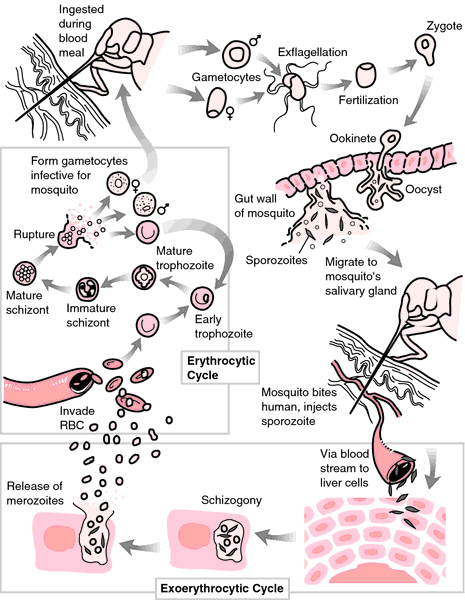Plasmodium
Also found in: Dictionary, Thesaurus, Encyclopedia, Wikipedia.
Plasmodium
[plaz-mo´de-um]a genus of sporozoa (family Plasmodiidae) parasitic in the red blood cells of humans and other animals; the malarial parasite. The organism is transmitted to the bloodstream of man by the bite of anopheline mosquitoes. The sporozoites migrate directly to the liver, where they develop and multiply within the parenchymal cells as merozoites, which then burst the liver cells and invade erythrocytes. Some of the merozoites develop into gametocytes, which are ingested by mosquitoes, beginning the sexual stage, which ends with the development of sporozoites. Four species, P. falci´parum, P. mala´riae, P. ova´le, and P. vi´vax, cause the four specific types of human malaria. 

Life cycle of Plasmodium spp. From Mahon and Manuselis, 2000.
plasmodium
[plaz-mo´de-um]1. a parasite of the genus Plasmodium.
2. a multinucleate continuous mass of protoplasm. adj., adj plasmo´dial.
Miller-Keane Encyclopedia and Dictionary of Medicine, Nursing, and Allied Health, Seventh Edition. © 2003 by Saunders, an imprint of Elsevier, Inc. All rights reserved.
Plasmodium
(plaz-mō'dē-ŭm),A genus of the protozoan family Plasmodidae (suborder Haemosporina, subclass Coccidia), blood parasites of vertebrates, characterized by separate microgametes and macrogametes, a motile ookinete, sporogony in the invertebrate host, and merogony (schizogony) in the vertebrate host; includes the causal agents of malaria in humans and other animals, with an asexual cycle occurring in liver and red blood cells of vertebrates and a sexual cycle in mosquitoes, the latter cycle resulting in the production of large numbers of infective sporozoites in the salivary glands of the vector, which are transmitted when the mosquito bites and draws blood. Primate malaria is transmitted by various species of Anopheles mosquitoes, bird malaria by species of Aedes, Culex, Anopheles, and Culiseta.
[Mod. L. from G. plasma, something formed, + eidos, appearance]
plas·mo·di·um
, pl.plas·mo·di·a
(plaz-mō'dē-ŭm, -dē-ă),A protoplasmic mass containing several nuclei, resulting from multiplication of the nucleus with cell division.
[Mod. L. fr. G. plasma, something formed, + eidos, appearance]
Farlex Partner Medical Dictionary © Farlex 2012
plasmodium
(plăz-mō′dē-əm)n. pl. plasmo·dia (-dē-ə)
1. A multinucleate, often large mass of protoplasm that moves and ingests food and is characteristic of the vegetative phase of plasmodial slime molds.
2. Any of various protozoans of the genus Plasmodium, which includes the parasites that cause malaria.
plas·mo′di·al (-dē-əl) adj.
The American Heritage® Medical Dictionary Copyright © 2007, 2004 by Houghton Mifflin Company. Published by Houghton Mifflin Company. All rights reserved.
Plas·mo·di·um
(plaz-mō'dē-ŭm)A genus of the protozoan phylum Apicomplexa and the order Haemospondia, blood parasites of vertebrates; includes the causal agents of malaria, with an asexual cycle in liver and red blood cells of vertebrates, and a sexual cycle in mosquitoes, the latter cycle resulting in the production of large numbers of infective sporozoites in the salivary glands of the vector, which are transmitted when the mosquito bites and draws blood.
[Mod. L. from G. plasma, something formed, + eidos, appearance]
plas·mo·di·um
, pl. plasmodia (plaz-mō'dē-ŭm, -ă)Protoplasmic mass with several nuclei, due to multiplication of the nucleus with cell division.
[Mod. L. fr. G. plasma, something formed, + eidos, appearance]
Medical Dictionary for the Health Professions and Nursing © Farlex 2012
Plasmodium
A genus of sporozoan parasites that invade red blood cells. The genus includes the four parasites that cause MALARIA.Collins Dictionary of Medicine © Robert M. Youngson 2004, 2005
plasmodium
- any parasitic sporozoan protozoan of the genus Plasmodium, esp. P. vivax, which causes malaria. 2 the vegetative phase of slime moulds (see MYXOMYCETE).
Collins Dictionary of Biology, 3rd ed. © W. G. Hale, V. A. Saunders, J. P. Margham 2005
Plas·mo·di·um
(plaz-mō'dē-ŭm)A genus of the protozoan family Plasmodidae blood parasites of vertebrates; includes the causal agents of malaria in humans and other animals, with an asexual cycle occurring in liver and red blood cells of vertebrates.
[Mod. L. from G. plasma, something formed, + eidos, appearance]
Medical Dictionary for the Dental Professions © Farlex 2012